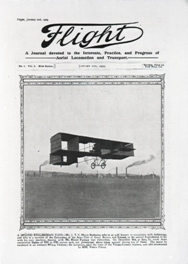
One hundred years ago this week, a new weekly aviation magazine hit the news stands, simply but appropriately named Flight.
That first issue, dated 2 January 1909, reported the exciting news that "England" could now boast that two of its citizens had now taken to the air, with the headline: "A second Englishman flies" - British aviation pioneer Mr J T C Moore-Brabazon on his Voisin biplane in France the previous month.
Since early in the decade, British weekly The Automotor Journal had been tracking aviation developments under the label Aeronautics. By 1908 UK aviation was beginning to make progress as A V Roe took his first tentative hops and the American Samuel Cody became the first person in the UK to fly when he took to the air at Farnborough in on 16 October. A month later The Automotor Journal signalled the imminent arrival of a standalone aviation magazine when from its 14 November issue, Aeronautics was replaced by Flight as the section title.
 Two months later, Flight appeared in its own right, and founder and editor Stanley Spooner laid out the magazine's principles, which remain valid to this day:
Two months later, Flight appeared in its own right, and founder and editor Stanley Spooner laid out the magazine's principles, which remain valid to this day:
"It is ...our firm determination to establish the same lofty traditions for Flight that have ever guided the editorial pen of The Automotor Journal in the automobile sphere, our chief aims and objects being ever to throw our full weight on the side of all that seems to us to make for the highest permanent good of the aeronautic industry, to pursue a policy of entire independence, and to render our pages as interesting, concise and accurately instructive as lies within our powers..."
He went on: "Those who have consistently pursued the Flight section of The Automotor Journal have obtained a useful start, but we do not wish readers of Flight to feel that their claims to begin at the beginning are being ignored. They will find that simple language and clear explanations are and will remain a feature of our articles - and if there is anything they do not understand they have only to ask."
Spooner remained editor right through the war years and into the early 1930s - the longest term in office in our first 100 years. He retired in 1934, as Flight became a part of the Iliffe stable of magazines, under the guidance of editorial director Geoffrey Smith. Danish-born "CM" (Carl Marcus) Poulsen, who had been with the magazine since 1911 and was technical editor during the First World War, replaced Spooner at the helm. He lead the magazine through the Second World War when he faced all kinds of reporting restrictions - particularly on the development and manufacture of new combat aircraft - before retiring and handing over to Maurice Smith in May 1949. By now, in its four decades since its creation, Flight had presided over aviation developments in two world wars and the beginning of the jet age. But this incredible progress would be more than equalled in the remaining 60 years of the magazine's first century.
Continue reading the history of Flight Magazine
Flight magazine - the early years
Max Kingsley-Jones describes Flight Magazine's humble birth
Flight magazine in the 80s and 90s
Allan Winn join Flight International as Editor in late 1988. 1998 he was promoted to editor-in-chief. He later served as publisher. He describes Flight International during this period
The future for Flight International
The launch of flightglobal.com has taken the wider Flight brand to a much bigger online audience

Source: Flight International
















